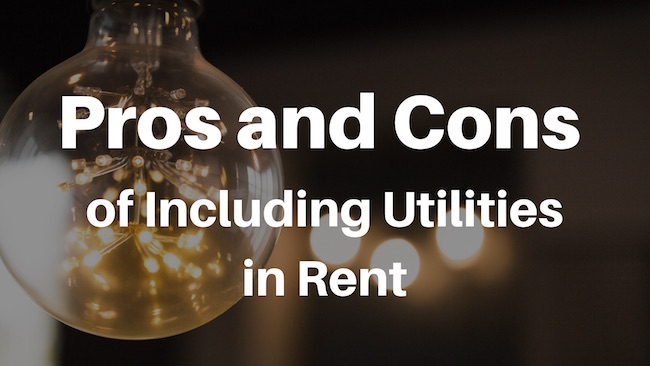Pros and Cons of Including Utilities in Rent

One of the many property management decisions that have to be made is whether or not include utilities in the rent.
Examples of utilities include electricity, natural gas, trash collection, water and sewer services, internet and telephone services, and security or alarm systems. When managing your rental property, you may choose to include all the utilities or a select few in the rent structures. However, you have to weigh the pros and cons of a utilities-included rent and see if this option makes sense for both you and the tenants.
If you own a rental property in Denver, Colorado you may want to take the time to think about the advantages and disadvantages of adding utility costs in the rent.
Denver Post has reported that rent prices in Denver are on the rise. Based on the April 2019 rent report by Apartment List, “Denver rents have increased 0.2 percent over the past month and have increased moderately by 2.0 percent in comparison to the same time last year.” In that case, it’s always a good idea to do your research before deciding whether or not to add utility costs in rent, as the higher rent price may scare potential tenants away.
Research shows that the average estimated monthly utility cost in Denver is $190. It is important for rental property managers to study the market and what their competitors are charging before adding utility costs on top of their rent price.
With that said, let’s take a look at what the pros and cons are in including utility costs in rent price.
Pros of Including Utilities with Rent:
Pro #1: Utilities are deductible expenses
When you charge for utilities with rent, you will be earning more rental income than if you didn’t. Which ultimately means you will be paying higher taxes.
Although this might seem like a downside, it isn’t. By paying for the utilities yourself you are able to claim them as a tax deductible. Something you would not be able to do as a landlord if the tenants paid their own utility bills.
Pro #2: A single bill is a selling point
With a utilities-included rent, tenants only have to worry about receiving and paying one fixed-bill. This is a selling point, as predictability helps tenants budget their monthly expenses. A fixed-bill means fewer payments for the tenants to worry about. It also means that they won’t have to deal with setting up the utilities in the first place.

Pro #3: Earning management fees
When you include utility costs in your rent, it only makes sense that you’ll charge more. That being said, you can also charge extra for taking on the responsibility of managing the utility bills. As much as a higher rent price may scare some potential tenants away, some may see it as you freeing them from the headache of utility companies. In that case, tenants may view the rent as reasonable and the price may just be right for them in the end.
Cons of Including Utilities with Rent:
Con #1: More responsibility for landlords
Since you are now the middle-man between the tenants and the utility companies, you have more management responsibilities. If an issue occurs, tenants are no longer expected to deal with utility companies. It is your role as a landlord to resolve any complaints or issues your tenants may have.
Con #2: Hard to predict accurate utility cost
The price of utilities fluctuates all the time. There is no guarantee that utility costs are the same every month. Conversely, having a utilities-included rent means having a fixed price for utility costs.
As a rental property owner, you have to take seasonal costs and frivolous tenants into account if you decide to include utilities with the rent.
There are seasonal costs that you must take note of. For example, tenants might increase the use of heating during the winter or use the air-conditioner more during the summer. Both of which will surely make the utility costs higher.
There are also frivolous tenants who do not care about conserving energy that you must consider. When utility costs are included in their rent they know they will be paying the same rate every month. Which gives them more reason to never turn off the lights or do an abundance of laundry, etc.
If you decide to charge a utilities-included rent, you might end up having to pay the extra expense out of your own pocket.

Con #3: The price might scare away potential tenants
Some potential renters who are searching for a property to rent don’t pay attention to the amenities and services included in the price. All they see is the numbers after the dollar sign. In such cases, they might not notice the “utilities-included” note in your advertisement and they might not even bother looking at your property. Especially when the price is not in their budget.
Obviously, there are no right or wrong answer in this situation. In some cases, it is best to include utility costs in rent and in others, it is not. Knowing the benefits and drawbacks of a “utilities-included” rent and evaluating each point is the first step in getting that answer. In the end, the decision should benefit the tenant but should also make the most financial sense for you.
